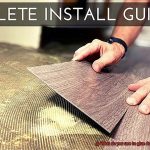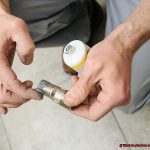Are you a fan of mosaic art? If you are, have you ever thought about incorporating it into your outdoor living area? Whether it’s the patio, walkway, or garden walls, a mosaic can add a stunning and unique touch to any outdoor space. But before you start your project, it’s important to know what materials to use.
To begin with, you’ll need tiles that are specifically designed for outdoor use. Ceramic, porcelain, and glass tiles are great options as they are durable and can withstand harsh weather conditions. Additionally, using waterproof adhesive and grout is crucial to ensure the longevity of your mosaic. And don’t forget about the substrate. It’s essential to have a strong and stable base that won’t shift or crack over time. Concrete boards or exterior grade plywood are excellent choices for this.
Creating an outdoor mosaic is an exciting and creative project that can elevate the look of your outdoor living space. However, it requires the right tools and materials. In this blog post, we’ll explore everything you need to create a breathtaking outdoor mosaic. So let’s get started.
What is Outdoor Mosaic?
Contents
Outdoor mosaic is an awe-inspiring art form that involves meticulously arranging small pieces of colored glass, stone, or ceramic to create stunning patterns or images. This medium has been utilized for centuries in diverse cultures worldwide to embellish public spaces, religious buildings, and private homes.
The key feature of outdoor mosaics is their ability to withstand exposure to the elements. As a result, special materials and techniques are required to ensure that the mosaic will not deteriorate over time. Choosing the right adhesive is one of the most crucial factors in creating an outdoor mosaic.
Thankfully, there are several types of adhesive that can be used for outdoor mosaics. Thinset mortar is a popular choice because it is strong, durable, and resistant to water. Epoxy is another common adhesive for outdoor mosaics because it creates a sturdy bond and is resistant to both water and UV radiation. Silicone adhesive is a flexible option that can be used on uneven surfaces or irregular shapes.
Apart from selecting the right adhesive, it is also important to seal the finished mosaic to protect it from moisture and other environmental factors. Applying a clear sealant to the surface of the mosaic creates a barrier that prevents water from seeping in between the tiles.
Types of Adhesives for Outdoor Mosaics
When embarking on an outdoor mosaic project, selecting the appropriate adhesive is crucial to ensure the longevity and stability of your artwork. Here are some different types of adhesives that you can use for your outdoor mosaic project:
Thinset Mortar
This cement-based adhesive is a popular choice for outdoor mosaics due to its strength and resistance to moisture. It is ideal for use in areas like patios or pool decks that are exposed to water and temperature fluctuations. However, it can be challenging to work with, requiring experience and precision during application.
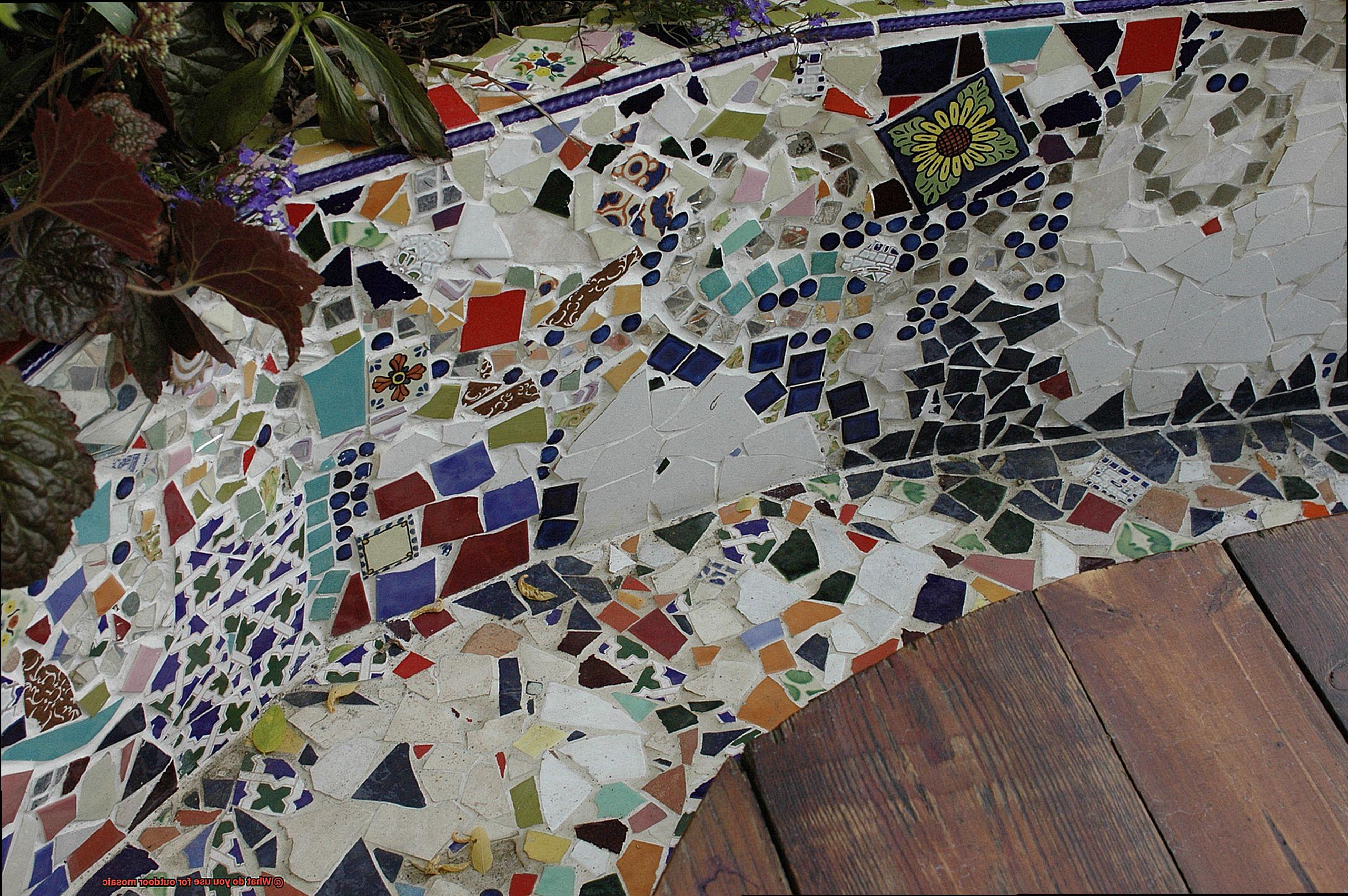
Epoxy
This two-part adhesive offers an incredibly strong bond between tiles and is also resistant to weathering and moisture. It’s perfect for outdoor installations that will face harsh weather conditions like rain or snow. However, it can be expensive and sets quickly, making it challenging to work with for larger projects.
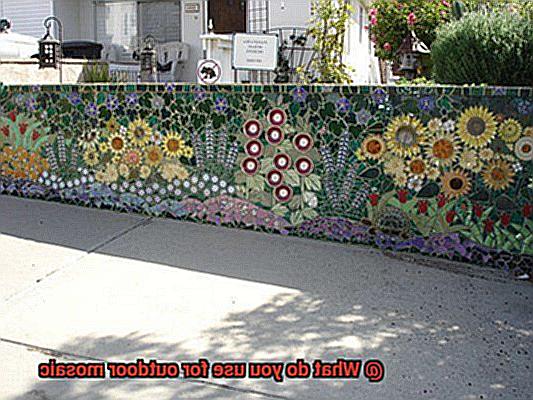
Silicone Adhesive
This waterproof adhesive is flexible and easy to apply, making it a popular choice for beginners. It dries clear, making it ideal for use with transparent or translucent materials such as stained glass or acrylic pieces. However, silicone adhesive may not provide as strong of a bond as other types of adhesives.
Specialty Mosaic Adhesives
There are also specialty mosaic adhesives available on the market that are specifically designed for outdoor use. These adhesives often contain additives that make them more resistant to weathering and UV damage, making them ideal for long-lasting outdoor mosaics.
Weldbond Adhesive
Another option is Weldbond adhesive, which is a universal adhesive that is known to work well with outdoor mosaics. It offers a strong bond between tiles and is also waterproof, making it resistant to moisture and weathering.
Benefits of Thinset Mortar
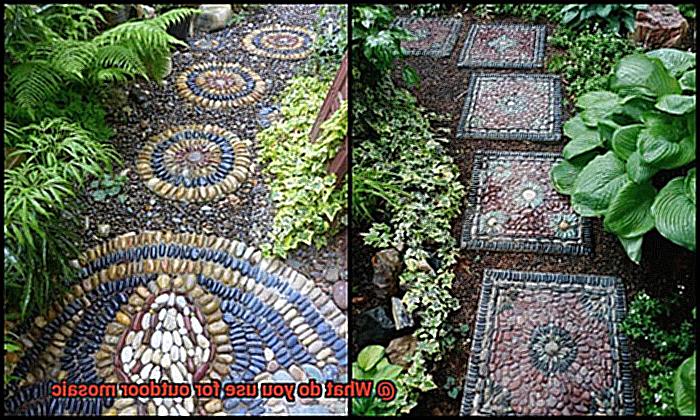
This versatile adhesive is made from a mixture of cement, sand, and a water-retaining agent that creates a slurry when mixed with water. The resulting slurry penetrates the substrate’s surface and forms a robust bond with the mosaic tiles, ensuring that they remain securely in place even in harsh weather conditions.
In addition to its exceptional bonding strength, thinset mortar is also highly resistant to moisture. Outdoor mosaics are often exposed to rain, snow, and condensation, which can cause other types of adhesives to weaken or fail altogether. However, thinset mortar’s waterproof property prevents water from seeping through the grout lines and damaging the substrate.
Lastly, thinset mortar can withstand extreme temperatures without losing its adhesive properties. During hot summers or cold winters, other adhesives may become brittle or soften, leading to a breakdown in the tile installation. But thinset mortar remains stable and durable even when exposed to these temperature variations.
To summarize, using thinset mortar for outdoor mosaic installations provides a long-lasting and reliable installation that homeowners can enjoy for years to come. Its superior bonding strength, resistance to moisture, and ability to withstand extreme temperatures make it the ideal adhesive for any outdoor mosaic project.
Benefits of Epoxy
Look no further than epoxy. As an expert on the benefits of epoxy, I can assure you that this adhesive is a superhero that will protect your tiles from the elements and ensure reliability.
Epoxy is an incredibly durable adhesive that can withstand exposure to the harshest of weather conditions. From rain to sun to wind, it has got you covered. This makes it an ideal choice for outdoor mosaics that will be exposed to harsh and unpredictable weather.
But that’s not all – epoxy is also highly resistant to water, chemicals, and abrasion, making it an excellent option for outdoor mosaics that will be installed in areas with heavy foot traffic. It’s easy to clean and maintain as well, making it a low-maintenance option for outdoor mosaic installations.
Another significant benefit of using epoxy for outdoor mosaics is its ability to bond well with various materials. Whether you are using glass, ceramic, stone, metal, or other materials commonly used in mosaic art, epoxy can bond them all. Its versatility makes it a go-to adhesive for mosaic artists who want to experiment with different materials in their artwork.
Moreover, epoxy is available in different types, including clear and colored options. This allows artists to choose an adhesive that complements their artwork’s color scheme or provides a clear finish that does not detract from the artwork’s design. This aesthetic benefit makes it even more appealing for mosaic artists who have a specific vision in mind.
Benefits of Silicone Adhesive
Look no further than silicone adhesive. This popular choice among mosaic artists offers a multitude of benefits that will ensure your creation withstands the test of time.
Firstly, silicone adhesive boasts exceptional durability. It can endure extreme temperatures and weather conditions, making it the go-to option for outdoor mosaics. Even after exposure to UV rays, this adhesive retains its strength and keeps your mosaic securely in place.
But wait, there’s more. Silicone adhesive is also impressively flexible. Unlike other adhesives that become brittle and crack over time, silicone allows for slight movement in the mosaic. This is especially significant for outdoor mosaics that might experience shifts due to temperature changes or ground movement.
In addition to its flexibility, silicone adhesive creates a strong bond between tiles and substrate. It adheres well to various materials such as concrete, wood, and ceramic, ensuring your mosaic stays put during harsh weather conditions.
Not only is silicone adhesive practical, but it’s also user-friendly. Its smooth texture makes it easy to apply evenly on the substrate without needing special tools or equipment.
Choosing the Right Adhesive for Your Project
Creating an outdoor mosaic is a fantastic way to add a personal touch of elegance and beauty to your garden or yard. However, the success of your project hinges on selecting the right adhesive. With so many options available, it can be daunting to choose the best one for your project. That’s why we’ve done extensive research and compiled a comprehensive list of factors to consider when selecting an adhesive for your outdoor mosaic.
Firstly, you should consider the type of materials you will be using in your mosaic. Different adhesives work better with certain materials like ceramic, glass, and stone tiles. Thinset mortar is a popular choice for outdoor mosaics made with these materials because it provides a robust and durable hold that endures harsh weather conditions.
Secondly, environmental conditions can significantly affect the longevity of your mosaic. This includes exposure to moisture or extreme temperatures. If your mosaic will be exposed to these conditions, then epoxy adhesive may be the ideal option. This two-part adhesive creates a waterproof bond and is resistant to UV rays and harsh weather conditions.
Thirdly, if your mosaic will be displayed in an area with high levels of foot traffic or heavy use, then a polyurethane adhesive may be the best option. This type of adhesive is highly durable and resistant to wear and tear over time while being waterproof and UV-resistant.
Applying the Adhesive Properly for Best Results
You’ll need to choose the right adhesive to ensure your creation lasts for years to come. In this guide, we’ll explore the two most popular adhesives for outdoor mosaics: thinset mortar and epoxy adhesive.
Thinset mortar is an excellent choice for outdoor mosaics due to its ability to endure harsh environmental conditions. This water-resistant adhesive is made from a mixture of cement, sand, and bonding agent, making it ideal for withstanding exposure to extreme temperatures and heavy foot traffic. To apply thinset mortar correctly, start by mixing it according to the manufacturer’s instructions.
Spread a thin layer onto the surface you’ll be adhering the tiles to using a trowel. Work in small sections to avoid the mortar from drying out too quickly. Once applied, press each tile into place, ensuring it’s level with the surrounding tiles.
Epoxy adhesive is another great option for outdoor mosaics as it provides a strong bond and is resistant to heat, chemicals, and UV rays. However, it’s best suited for non-porous surfaces such as metal or glass.
To apply epoxy adhesive properly, you’ll need to mix equal parts of resin and hardener together until they’re thoroughly blended. Then, use a trowel or putty knife to spread a thin layer onto the surface you’ll be adhering the tiles to. Press each tile into place, ensuring it’s level with the surrounding tiles.
Regardless of which adhesive you choose, following the manufacturer’s instructions carefully is crucial for achieving the best results. Take your time and work in small sections to ensure that your mosaic project remains beautiful and long-lasting.
Maintenance and Care Tips for Outdoor Mosaics
Outdoor mosaics are stunning and intricate works of art that can elevate the aesthetic appeal of your outdoor space. However, they require proper maintenance and care to ensure their longevity and beauty. Here are five sub-sections that explain the maintenance and care tips for outdoor mosaics in detail:
Regular Cleaning
Regular cleaning is crucial to keep your outdoor mosaic looking new. Dirt and debris can accumulate on the surface, making it lose its shine. Use a soft-bristled brush or cloth and mild soap and water to gently clean the tiles. Avoid using abrasive cleaners or scrubbers as they can scratch the surface of the mosaic.
Sealing
Sealing is an essential step to protect your outdoor mosaic from moisture, UV rays, and other environmental factors that can cause damage. Choose a sealant that is specifically designed for outdoor use and follow the manufacturer’s instructions carefully. Apply the sealant every few years to maintain the protection.
Repairing Damaged Tiles
If you notice any cracks or missing tiles in your mosaic, it is important to repair them as soon as possible. Cracks or missing tiles can allow moisture to penetrate the surface and cause further damage. You can use a tile adhesive to replace missing tiles or repair cracks. Hiring a professional mosaic artist is also an option.
Protecting from Extreme Weather
Extreme weather conditions such as freezing temperatures or excessive heat can cause significant damage to your mosaic. To protect it, cover it with a tarp or move it indoors during extreme weather conditions.
Avoiding Heavy Objects
It is crucial not to place any heavy objects on your outdoor mosaic as it can cause damage to the tiles. Instead, use a sturdy base or stand to display your artwork.
L_aaGEYmnM8″ >
Conclusion
In conclusion, an outdoor mosaic can be a stunning addition to any garden or yard. However, the key to a successful project lies in selecting the right adhesive. Opting for materials like ceramic, porcelain, or glass tiles that are specifically designed for outdoor use is essential. And don’t forget about waterproof adhesive and grout.
When it comes to adhesives, thinset mortar is a top choice thanks to its strength and resistance to moisture. It’s perfect for areas exposed to water and temperature fluctuations, such as patios or pool decks. Epoxy is another popular option due to its sturdy bond and resistance to both water and UV radiation. Meanwhile, silicone adhesive offers flexibility for uneven surfaces or irregular shapes.
But choosing the right adhesive is just the start. You’ll also want to seal your finished mosaic to protect it from moisture and other environmental factors. Regular cleaning, sealing, repairing damaged tiles, protecting from extreme weather conditions, and avoiding heavy objects are all important maintenance tips that can help keep your outdoor mosaic looking new.
Ultimately, creating an outdoor mosaic requires careful consideration of various factors such as materials used, environmental conditions, adhesives chosen, application techniques employed as well as maintenance tips applied.


